As an Amazon Associate, I earn from qualifying purchases with no additional costs for you.
Hidden in the grassy plains and scattered lakes of Indiana, there are many intriguing rocks and minerals that rockhounds can take home. Learn about Indiana’s world-famous limestone, colorful celestine, and other common rocks and minerals in this overview.
Some common rocks and minerals you might find in the Hoosier State are:
- limestone,
- sandstone,
- chert,
- siltstone,
- dolostone,
- shale,
- geode,
- calcite,
- pyrite,
- fluorite,
- sphalerite,
- celestine,
- gold,
- and quartz.
All you need to find all sorts of rocks, minerals, and gemstones in Indiana are the right rockhounding tools and information. Plan your rockhounding trips in Indiana using this guide of common rocks and minerals, along with their locations.
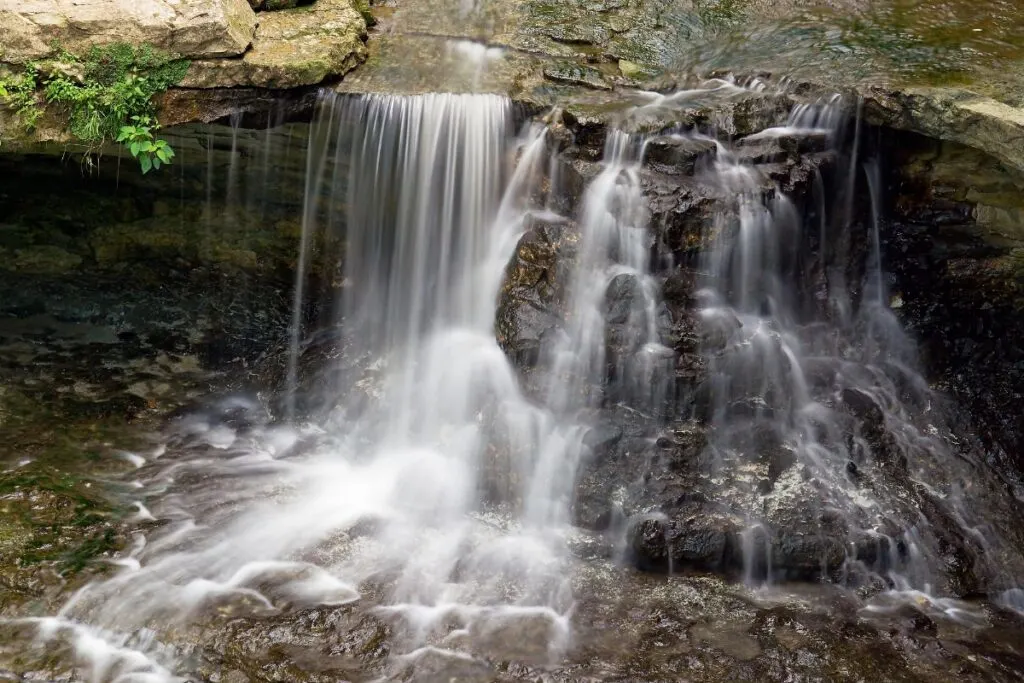
If you are interested in checking out the best rockhounding tools you can find them by clicking here (Amazon link).
What Rocks Are Found in Indiana
While there are some igneous rocks that floated into Indiana during the glacial drift that occurred thousands of years ago, the most common rocks are sedimentary, such as:
Limestone
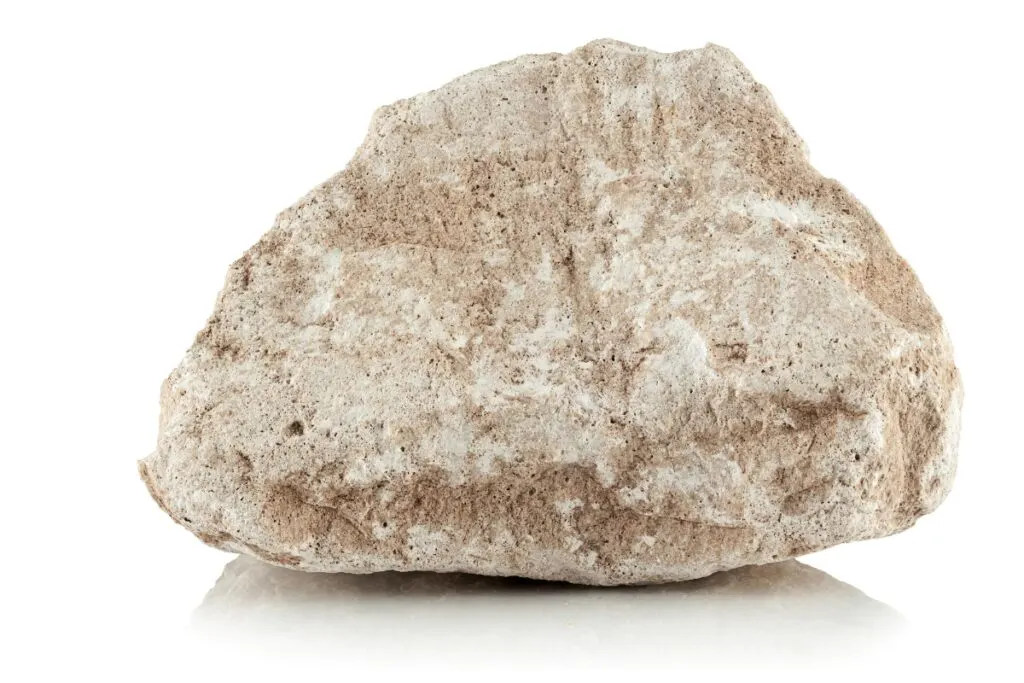
| Location | GPS Coordinates |
|---|---|
| Bedford | 38.876462, -86.509090 |
| Bloomington | 39.197551, -86.521547 |
| Lawrence County | 38.795497, -86.470755 |
| Owen County | 39.259358, -86.900510 |
| Monroe County | 39.066008, -86.467936 |
| Stinesville | 39.302518, -86.650174 |
Most people know that the limestone used for the Pentagon and Empire State Building is of the finest quality, but what they don’t know is that the limestone used for these buildings originates from Indiana!
In 1971, Indiana designated limestone as their state stone, and this specific type of stone is famous for its durability, uniformity of color, and ability to hold fine details.
Indiana Limestone, also known as Salem Limestone or Bedford Limestone, is porous, medium-grained, and light blue to grey in color.
Since Bedford is known as the “Limestone Capital of the World,” it makes sense that rockhounds who are on the hunt for it flock to this city. Bedford, Bloomington, and other areas in Lawrence County are must-see locations for anyone who wants to find this famous limestone.
Sandstone
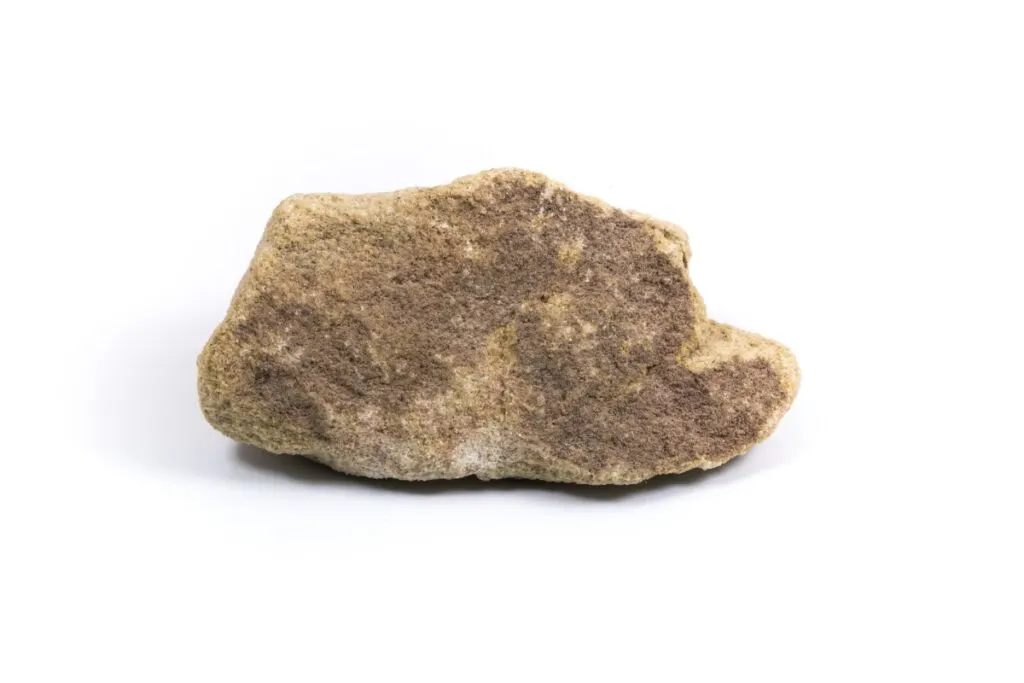
| Location | GPS Coordinates |
|---|---|
| Brown County | 39.231801, -86.236405 |
| Mansfield | 39.676001, -87.102150 |
| Brazil | 39.507461, -87.118225 |
| English | 38.337869, -86.457051 |
| Monroe County | 39.064408, -86.516001 |
| Vermillion County | 39.952175, -87.504040 |
As you explore the Hoosier State, there are multiple types of sandstone that you might see. St. Peter Sandstone, Mt. Simon Sandstone, Degonia Sandstone, Waltersburg Sandstone, and Mansfield Sandstone are just a few types that you might encounter, and they usually contain high amounts of quartz and other minerals.
For high-quality Indiana sandstone, look near Brown County, Mansfield, and Brazil. You can also check out the areas near the quarries in Monroe County and Vermillion County.
Chert
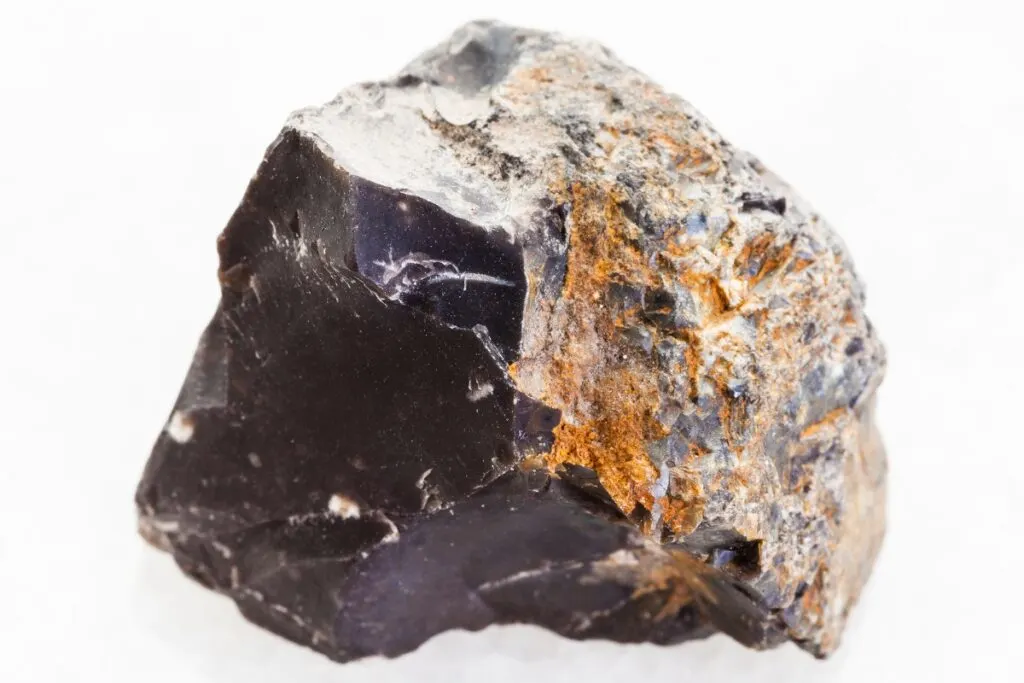
| Location | GPS Coordinates |
|---|---|
| Wabash River | 39.450740, -87.425917 |
| Liston Creek | 40.676225, -85.912308 |
| Holland | 38.250182, -87.038360 |
| Laurel | 39.502366, -85.182176 |
| Derby | 38.030001, -86.527116 |
| Burlington | 40.486549, -86.393984 |
| Wyandotte | 39.231801, -86.236405 |
Indiana chert, also called Indiana Hornstone, is a high-quality chert that was used by Native Americans to fashion arrowheads and tools. This type of chert can come in multiple colors, including white, tan, brown, black, grey, and red.
The Wabash River is a great site to find chert, and rockhounds also search near Holland, Laurel, and Derby.
TIP: Chert is one of the most frequent and popular sedimentary rocks in the world. Check out the guide where to find chert in the United States below:
Where to Find Chert: Best Environments & Locations (USA)
Siltstone

| Location | GPS Coordinates |
|---|---|
| Bloomington | 39.197551, -86.521547 |
| Brown County | 39.231801, -86.236405 |
| Perry County | 37.936874, -86.657487 |
| Orange County | 38.540172, -86.505046 |
| White River | 39.389340, -86.487598 |
| Martin County | 38.698018, -86.819162 |
As you would expect from a state that’s full of sedimentary rocks, there is plenty of siltstone that can be found all over Indiana.
Siltstone only forms underwater, so it’s usually formed in the creeks and rivers of this state. Indiana siltstone tends to be blue-grey to dark green in color, and it’s surprisingly durable.
Any of the creeks, streams, and rivers in Indiana are fair game for siltstone and other sedimentary rocks. Take a look around Bloomington, Brown County, and the White River for this sedimentary stone.
Dolostone
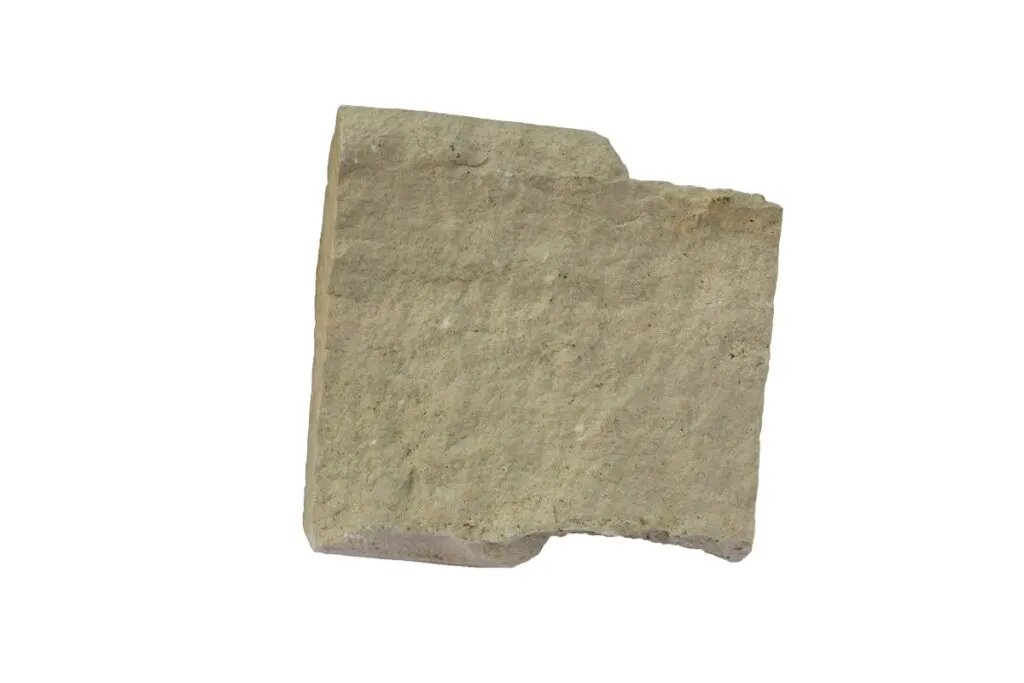
| Location | GPS Coordinates |
|---|---|
| Monroe County | 39.259267, -86.520807 |
| Salamonie River | 40.819080, -85.698046 |
| Harrison County | 38.194519, -86.038610 |
| Indianapolis | 39.653433, -85.965221 |
| Perry County | 38.166132, -86.697999 |
| Harrodsburg | 39.017536, -86.541211 |
| Laurel | 39.502366, -85.182176 |
Since there’s large amounts of limestone in Indiana, you can expect dolostone to be nearby. Although Indiana dolostone is similar to limestone in appearance, it’s a much harder material.
While dolostone exists all over Indiana, the deposits near the upper Salamonie River are known for their purity and quality, so it’s a popular place for rockhounds to visit.
As mentioned, the Salamonie River has some of the best deposits of dolostone in Indiana, but rockhounds also look near Monroe County and Harrison County.
Shale
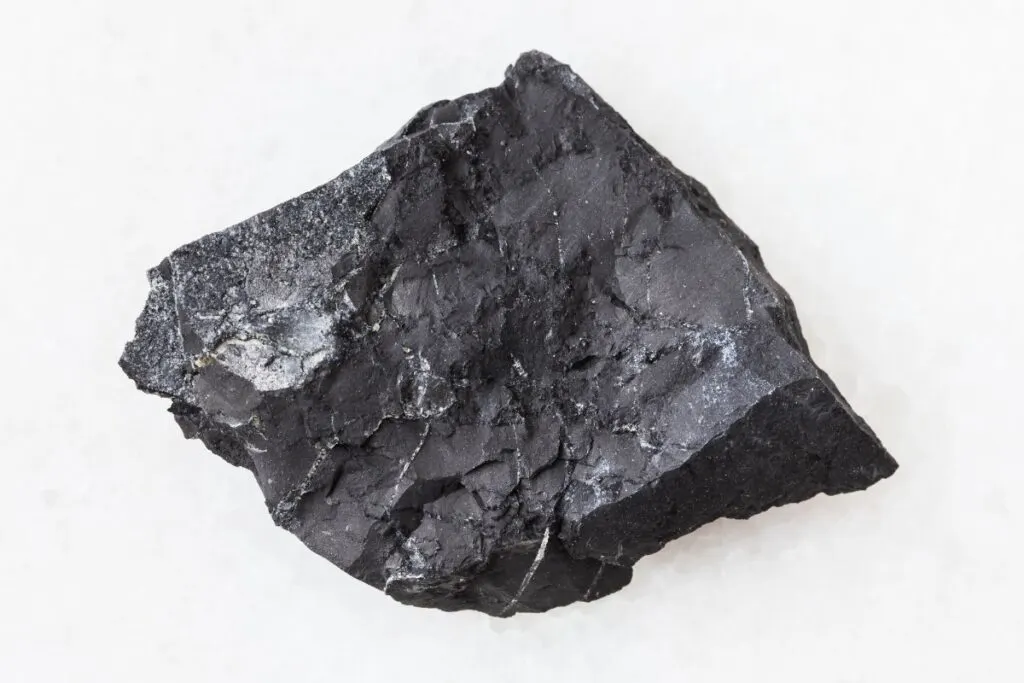
| Location | GPS Coordinates |
|---|---|
| Posey County | 37.930559, -87.862157 |
| Harrison County | 38.085969, -86.191045 |
| Decatur | 40.819180, -84.908289 |
| Bartholomew | 39.175930, -85.896057 |
| Rush County | 39.583855, -85.490951 |
| Blocher | 38.717778, -85.656545 |
There are a couple different types of silty shale that rockhounds can find in the Hoosier State, such as New Albany Shale, Seimer Shale, Somerset Shale, Grassy Creek Shale, and more. Indiana shale can appear grey, green, brown, or black, depending on the type of shale and the region where it’s found.
For Indiana shale, search near Rush County, Posey County, and Harrison County. Rockhounds also stop by Decatur and Bartholomew for this sedimentary rock.
Recommendation box: All tools and equipment you need for rockhounding and rock identification* (Amazon links):
1. Estwing Rock Hammer – Light, comfortable, and extremely durable hammer.
2. Estwing Geologist Pick – Classic and the most trusted paleo pick in the world.
3. Finder 12-inch Chisels – Heavy-duty chisels set with hand protection.
4. Mini Handle Shovel – This is a great tool for digging deep in the dirt.
5 Ironclad Utility Work Gloves – Breathable, but they also protect the areas requiring them most.
6. 3M Safety Glasses – Comfortable and efficient goggles for rockhounding.
7. Convoy 8+ UV Light – 365nm UV LED flashlight with a patented glass filter.
8. Wesley’s Jewelers Loupe – High magnification options (30X and 60X) with carrying case.
9. Mohs Hardness Kit – A specially designed kit for rockhounds
*All recommended products are personally tested and regularly used by experts from this website.
Geode
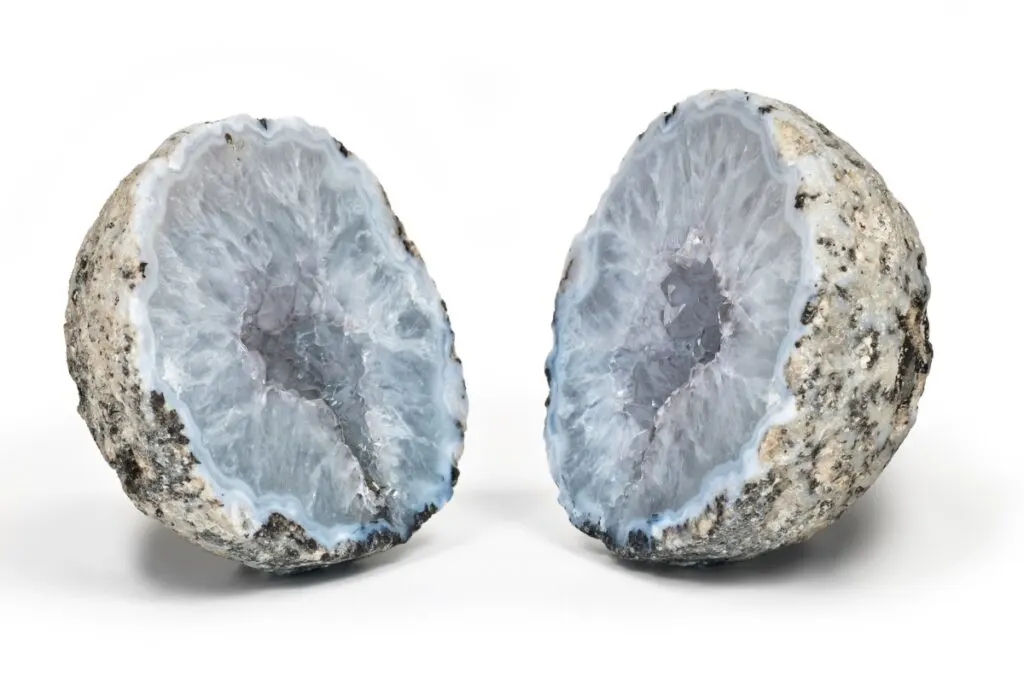
| Location | GPS Coordinates |
|---|---|
| Brown County | 39.212119, -86.227478 |
| Hoosier National Forest | 38.478481, -86.524458 |
| Beanblossom Creek | 39.269296, -86.266803 |
| White River | 39.374878, -86.534194 |
| Salt Creek | 39.111540, -86.424901 |
| Jackson County | 38.893566, -86.036783 |
From roadsides to rivers, there are multiple areas in Indiana where rockhounds can find geodes. These geodes often contain pyrite, calcite, quartz, celestine, and sphalerite. Geodes from the Hoosier State can also contain chalcedony, siderite, aragonite, and fluorite.
The best places to find geodes in Indiana include Brown County, Jackson County, and the White River in Lawrence County. Some rockhounds also stop by the Hoosier National Forest for all kinds of geodes and other rocks.
What Minerals Are Found in Indiana
Along with all its rocks, Indiana also has some interesting minerals, such as:
Calcite
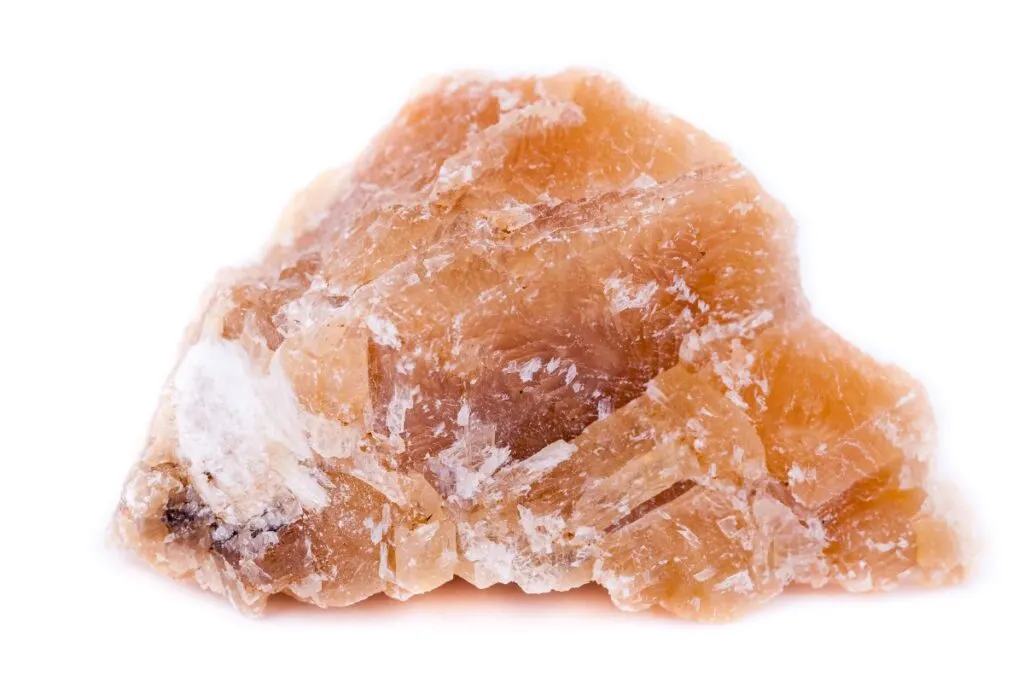
| Location | GPS Coordinates |
|---|---|
| Huntington | 40.879239, -85.481245 |
| Elizabethtown | 39.140000, -85.809857 |
| Bloomington | 39.201276, -86.522920 |
| Norristown | 39.368943, -85.762254 |
| Harrodsburg Road Cuts | 39.017736, -86.542499 |
| Lawrence County | 38.808340, -86.487235 |
| Coryden | 38.218788, -86.122132 |
Although Indiana calcite is extremely common in geodes and other crystal formations, it’s rare to find it by itself in this state.
In Indiana, calcite is typically yellow, brown, or colorless, and it’s known for its high clarity. Sometimes, rockhounds find brighter colors of calcite, but they are very rare in the Hoosier State.
Fortunately, calcite is one of the most abundant minerals in Indiana, so you won’t need to spend hours searching for it. Travel to Huntington, Elizabethtown, or Bloomington for high-quality pieces of this mineral.
Pyrite
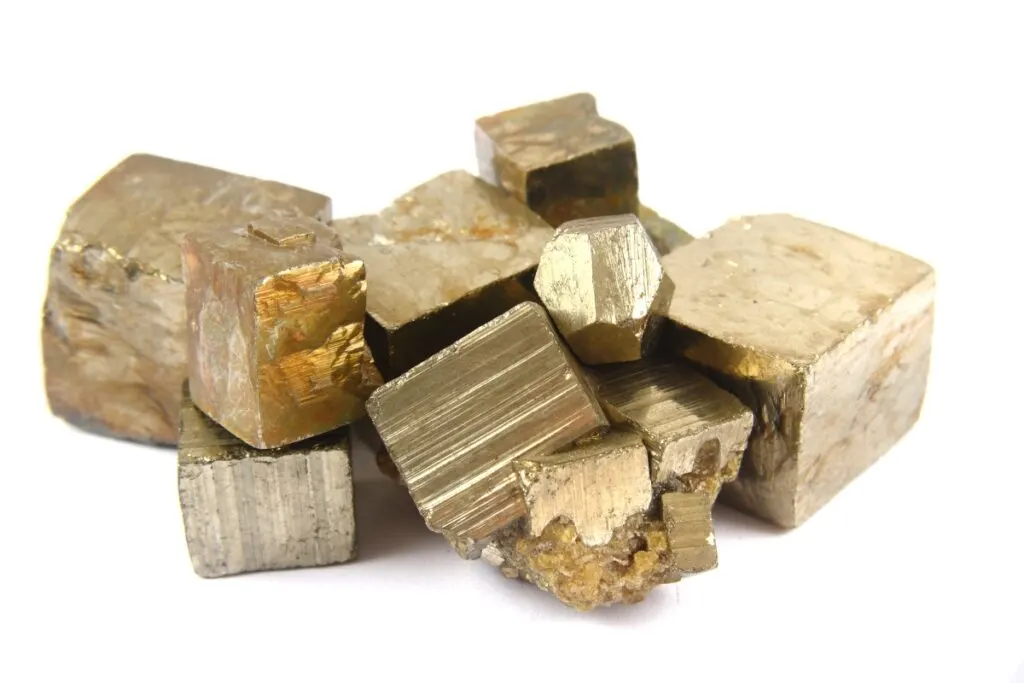
| Location | GPS Coordinates |
|---|---|
| Huntington | 37.507245, -88.279897 |
| Jasper County | 38.131838, -89.693372 |
| Floyd County | 37.411932, -88.350780 |
| Parke County | 41.782184, -88.366460 |
| Bluffton | 37.467342, -88.171131 |
| Logansport | 41.337132, -88.470965 |
| Bicknell | 37.169259, -88.454639 |
It’s true that rockhounds can discover gold in Indiana. Before you start to celebrate, however, remember that this state also has plenty of pyrite.
While pyrite might not be as valuable as gold, its color and shine are still quite beautiful, and Indiana pyrite sometimes has small amounts of gold locked up in its structure. You can find pyrite inside geodes or by itself, depending on where you go in the state.
To add this shiny mineral to your collection, visit Jasper County, Floyd County, and Parke County. Huntington is also a popular site for this mineral and many others.
TIP: Pyrite and gold can appear similar to the untrained eye but are quite different minerals. Find out more in the article below:
Pyrite vs. Gold: 11 Key Differences (Never Get Wrong Again)
Fluorite

| Location | GPS Coordinates |
|---|---|
| Bloomington | 39.201276, -86.522920 |
| Elizabethtown | 39.140000, -85.809857 |
| Lawrence County | 38.808340, -86.487235 |
| Norristown | 39.368744, -85.762468 |
| Coryden | 38.218788, -86.122132 |
| Crawford County | 40.063029, -86.893280 |
While fluorite tends to come in many colors, the specimens from Indiana are transparent, yellow, or light brown. Despite their lack of bright colors, the fluorite crystals from this state are well formed and have great shape.
Rockhounds dig for Indiana fluorite in Bloomington, Elizabethtown, and Coryden. You can also find some near Crawford County and Lawrence County.
Sphalerite

| Location | GPS Coordinates |
|---|---|
| Newton County | 40.931448, -87.381910 |
| Huntington | 40.881446, -85.534803 |
| Parke County | 39.792685, -87.204665 |
| Lawrence County | 38.808340, -86.487235 |
| Big Pine Creek | 40.476563, -87.212019 |
| Allen County | 41.082349, -84.977365 |
Sphalerite, a zinc mineral that’s known for its shine, appears with black, white, or golden crystals in Indiana.
Crystals with darker colors have higher amounts of iron, while lighter colors or transparent crystals have little iron and are considered “pure.” Typically, rockhounds will discover this mineral alongside galena, which is also common in the Hoosier State.
Sphalerite is widespread in Indiana, and you can find it in Newton County, Parke County, Allen County, and Lawrence County.
Celestine
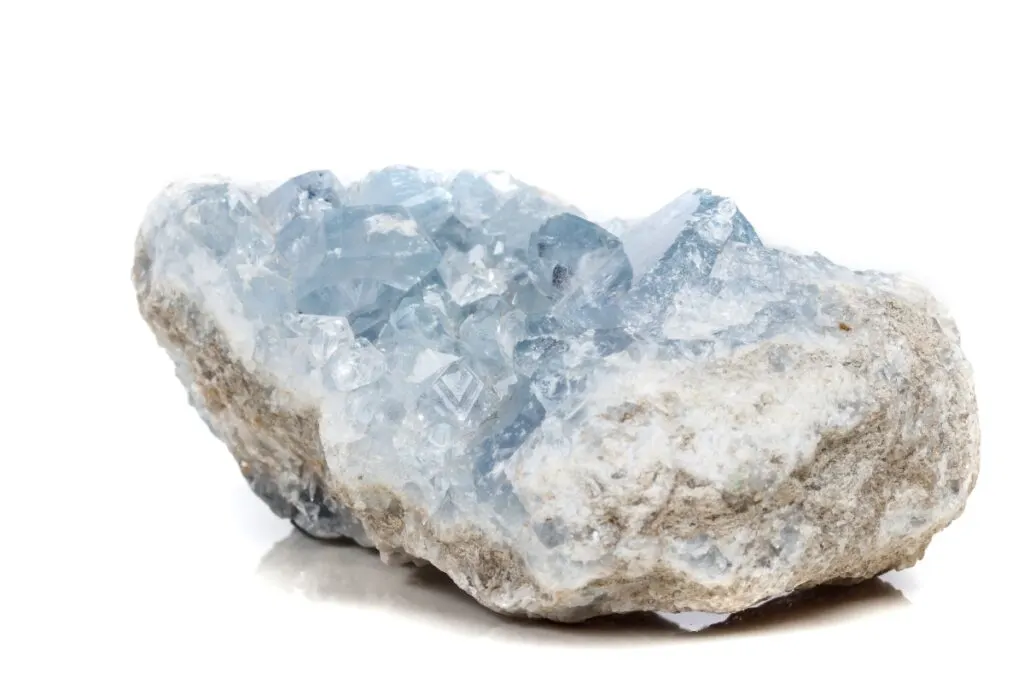
| Location | GPS Coordinates |
|---|---|
| Spencer | 39.281573, -86.765775 |
| Lawrence County | 38.838832, -86.419944 |
| Buddha | 38.792771, -86.406114 |
| Washington County | 38.651052, -86.145449 |
| Mitchell | 38.741286, -86.462316 |
| Salem | 38.607075, -86.093383 |
Celestine, also known as celestite, is a gorgeous blue mineral that contains strontium, a rare earth metal. Although celestine can display dark shades of blue, the specimens that come from Indiana are generally light blue crystals.
Spencer County and Lawrence County are some of the best places to search for celestine, especially near the mines. Rockhounds also dig near the Hoosier Quarry in Washington County for this lovely mineral.
Gold
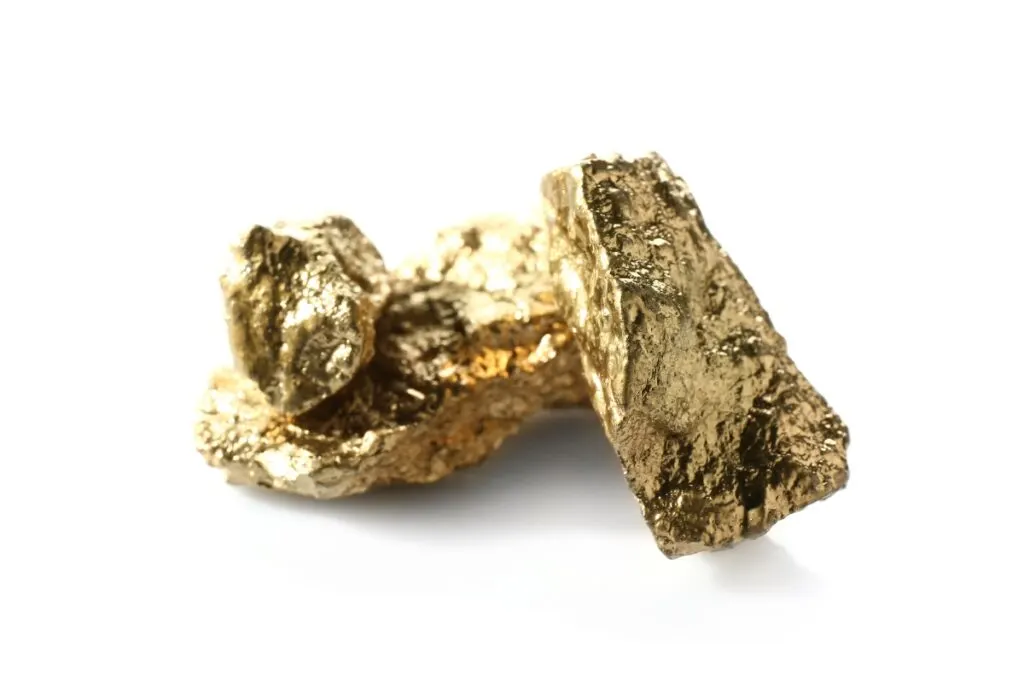
| Location | GPS Coordinates |
|---|---|
| Brown County | 39.254136, -86.196579 |
| Salt Creek | 39.103815, -86.420609 |
| Monroe County | 39.233742, -86.525957 |
| Greenhorn Creek | 39.128172, -86.196378 |
| Sycamore Creek | 39.486435, -86.431323 |
| Morgan County | 39.529293, -86.524985 |
It’s true that the Hoosier State doesn’t have as much gold as larger states such as California or Alaska, but gold panning is alive and well in Indiana. Thousands of years ago, glacial drift brought gold into Indiana and surrounding states.
Rockhounds rarely find nuggets or anything larger than small grains, but gold flakes certainly exist in this state. Gold flakes have been found in many of Indiana’s rivers and streams, so if you enjoy collecting gold dust and grains, you’re in luck!
Some areas that are known for their gold are Salt Creek, Greenhorn Creek, Sycamore Creek, and Indian Creek. Also, you can pan in some of the smaller streams near Brown County and Monroe County.
Quartz
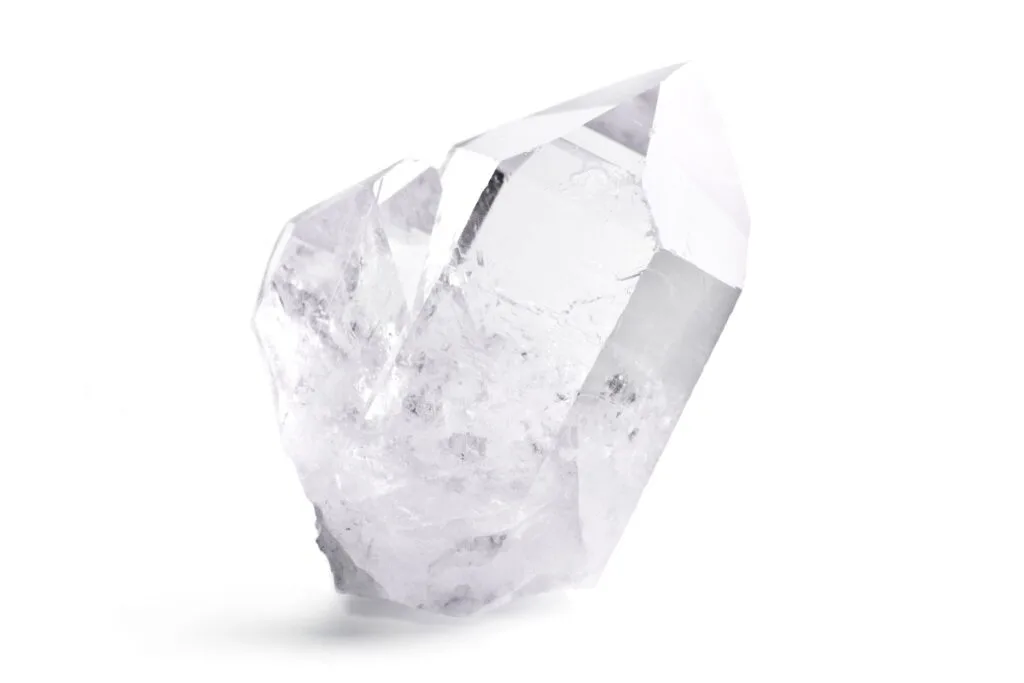
| Location | GPS Coordinates |
|---|---|
| Monroe County | 39.233742, -86.525957 |
| Brown County | 39.254136, -86.196579 |
| Williams Creek | 39.887847, -86.142137 |
| Salt Creek | 39.103815, -86.420609 |
| Morgan County | 39.529293, -86.524985 |
| Huntington | 40.881446, -85.534803 |
Quartz is one of Indiana’s most common minerals, and you can find it anywhere in the state. Small pieces of quartz are common, while larger and more impressive specimens are rare but have been found.
Rockhounds can find independent crystals or quartz geodes in Indiana, and they are often discovered alongside limestone. Without a doubt, clear quartz is the most abundant type of quartz in this state, but amethyst is present in certain areas, such as Marion County and
Wherever you go in Indiana, you are bound to run across some quartz. Check out Monroe County, Williams County, and Morgan County for quartz crystals and geodes.
FAQ About Common Rocks & Minerals in Indiana
Now that we’ve covered the common rocks and minerals of Indiana, let’s take a look at the rare ones, including:
What Rare Rocks Can You Find in Indiana
In Indiana, you can pick up all kinds of rare rocks, such as agates, jaspers, geodes, Bedford Limestone, and even petrified wood. Indiana’s petrified wood is ancient and can be over 300,000,000 years old!
Although there are many rocks in Indiana, Bedford Limestone is truly one-of-a-kind. Limestone is common all over the world, but the exceptional quality and color of Bedford Limestone places it in a league of its own, which is why it’s a popular find for rockhounds.
Bedford and Brown County are two of the most popular places for rockhounds who want to collect rare rocks. For petrified wood, Big Pine Creek and Allen County are two of the best places to look.
BTW: Do you want to know more about rock and mineral identification? The books listed below are the best ones you can find on the internet (Amazon links):
- Smithsonian Handbooks: Rocks & Minerals
- Gemstone & Crystal Properties (Quick Study Home)
- Ultimate Explorer Field Guide: Rocks and Minerals (National Geographic Kids)
What Rare Minerals Can You Find in Indiana
Did you know that you can find some of the most valuable minerals on earth in Indiana? Diamonds, gold, celestine, sphalerite, topaz, amethyst, moonstone, garnet, peridot, and sapphire are some of the most popular finds from Indiana, with diamonds at the top of the list.
Rockhounds who were panning for gold stumbled upon diamonds instead. So, if you decide to pan for gold in this state, don’t be surprised if you end up with diamonds instead!
Any rockhound who wants to add some of these rare minerals to their collection should travel to Brown County, Morgan County, and Lawrence County, three areas known for their wide array of valuable rocks and minerals.
What is the Most Famous Rock or Mineral Found in Indiana
Indiana’s famous limestone goes by multiple names, including Salem Limestone, Bloomington Limestone, Bedford Limestone, and more. These limestones are named after the areas where they are found, and they are famous for their purity and consistent high quality.
Indiana Limestone was used to build some of the world’s most famous monuments, including the Lincoln Memorial, Pentagon, Empire State Building, Grand Central Station, and Tribune Tower.
Indiana Limestone is a freestone, meaning that it can be cut and carved in almost any shape and size, so it’s an ideal material for carving and sculpting enthusiasts.
Some of the most popular places to visit for Indiana Limestone are Salem, Bloomington, Bedford, White River, Ellettsville, and Lawrence County.
You can still find limestone in other parts of the state, but it might lack the quality and purity of the pieces found in these specific areas.
Conclusion
When you visit the Hoosier State, you will come across all kinds of rocks and minerals, such as Bedford Limestone, diamonds, pyrite, geodes, and more. Rockhounds can also pan for gold in the Indiana rivers and streams, which have produced diamonds in the past.
While Brown County is currently one of the most popular counties for visiting rockhounds, there are other counties in this state that are worth a visit.
For example, Washington County isn’t as popular as Brown County, but it is home to many alluring minerals, including celestine and sphalerite.
So, no matter where your travels take you in the Hoosier State, you’ll be able to uncover all sorts of unique, high-quality rocks and minerals to commemorate your Indiana adventures.
TIP: The entire state of Indiana is worth visiting because there are so many gems to find if you know where to search. Check out the complete guide below:
Best Rock Hunting Sites & Beaches in Indiana What to Find
